Tinkering with Open Space!
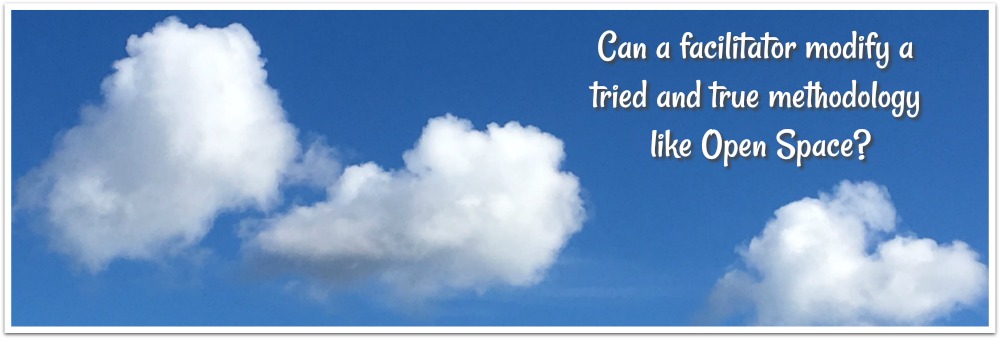
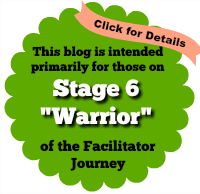
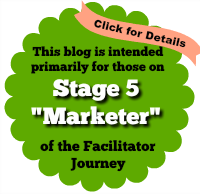 A number of colleagues and I occasionally debate whether it’s ok to modify a well known, well established, outstanding framework. In the course of a recent conversation, a few of us came up with a modification to one of the steps in the Open Space Technology (OST) framework.
A number of colleagues and I occasionally debate whether it’s ok to modify a well known, well established, outstanding framework. In the course of a recent conversation, a few of us came up with a modification to one of the steps in the Open Space Technology (OST) framework.
For me, OST has always been a challenge to both facilitate and be a participant. Yet, there are many good reasons to NOT tinker with tried-and-true tools and frameworks. However, with some nervousness, I am going to propose a change to this framework to make it potentially more inclusive. It may not work for all situations or facilitators. (Notice how hesitant I am with my words here). For me with my usual use of ToP methods – this change makes it more comfortable because it offers profound respect for everyone’s input and preferred ways to participate. I also think it might get better results. I believe this modification does NOT tinker with the values and principles that are inherent in OST. Read on and see if you agree!
A full description of OST is included in this blog. This framework typically is used with larger groups (>20) who have emerging agenda items for which they would like input. It’s a wonderful methodology in situations where you cannot predict exactly what the participants’ needs are beforehand. It allows a lot of important subject matter to be discussed by people who are vested in the subject theme. The discomfort I have with using OST primarily comes at the beginning of the “Agenda Setting” step. This is where I’m offering a modification.
Open Space modification – here we come!
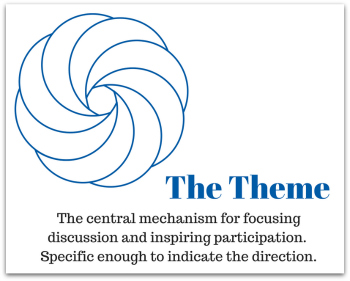
After the principles and format of OST are made very clear, people are typically asked to come forward and propose a topic on which they want people to work. This is called the “Agenda Setting” step. The number of topics proposed can often be substantial.
This is what found in one guide to the typical OST “Agenda Setting” step (link to Resource Guide with full instructions for all steps is noted in the Resource section at the end of this blog):
“To get `from here to there’ we will use two very simple mechanisms — the Community Bulletin Board, and the Village Market Place. In a few moments, I will ask you to identify any issue or opportunity you see around our theme, give it a short title and write that down on the paper provided. Then stand up in front of the group, say what your issue is, and post the paper on the wall. Make sure that you have some real passion for this issue, and that it is not just a good idea for somebody else to do. For you will be expected to take personal responsibility for the discussion. That means saying where and when the group will meet, convening the group, and entering the results of your discussion into our computer system (if you are using a system). You may offer as many issues as you like, and if at the end of the day, you do not see your issue on the wall, there is exactly one person to complain to. Yourself.
“Once all the issues are up, we will then open the Village Market Place, and everybody will be invited to come to the wall and sign up for as few or as many of the groups as they desire. From there on out, you are in charge.
“Even though Open Space is truly open, there are some principles and one law that we need to keep in mind. The Four Principles are. . . [see above]. And the Law is what we call the Law of Two Feet. Everybody has them. . . . [see above].”
The Proposed Modification
Instead of having everyone think about whether they want to offer a topic, I’m wondering if it would be helpful to have them first meet in small groups of 3-4. Each person would then take 1 minute to think out loud with the other group members devoted attention, to sketch out potential ideas they might offer before they offer it to the larger group. For some group members they might simply say, “I don’t have anything to offer but I’d be interested in contributing or listening to the following topics.”
Each person in the small group would take a turn at being listened to around their potential topic choices. After everyone has spoken, the small group might merge common topics and together propose 1-2 clearly stated topics to the larger group.
The total amount of time needed to do this “extra” sub step in the Agenda Setting step would be about 10 minutes.
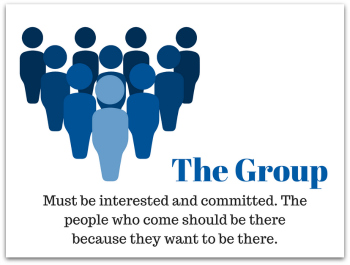
- You don’t feel alone in proposing a topic to the larger group because you now have a partner with whom to lead the topic.
- Everyone has time to think out loud and test the idea with the smaller group to clarify your thinking.
- You narrow down the topics being proposed (if this might be a problem for the size of group you have).
- You now know a little bit about 2 topics being proposed and have an easy first choice about what to sign up for if you’re not going to lead
one.
The added step might look like this:
- Get in small groups of four people. Each take one minute to share any topics you are thinking about offering or any topics you are interested in. Everyone gets the same amount of time. When one person is speaking, everyone just listens – no interruptions. Imagine this person is just trying to do “out loud thinking” to help them clarify their thoughts. I will ring a bell after each one minute or you can use your own timer.
- When everyone has shared, together discuss where you heard as potentially common topics
- Decide together which two topics you will offer to the whole group and who will lead and co-lead, if desired. Anyone can ask someone in the group to stand up with them to make it less intimidating to offer their proposal to the whole group.
(Then you go back to the community bulletin board step noted above)
In Summary
I have avoided using Open Space Technology because I neither feel qualified to offer a topic or interested enough in someone else’s topic to fully participate. This tinkering of the Agenda Setting step would allow me to gain more ownership in the process. What do you think? As you review the overview below, can you see yourself using this modification?
Description
OST creates the supportive environment in which the participants solve self-determined issues. Minimal elements of this framework include: Opening, Agenda Setting, Open Space, and Conclusion. These elements will suffice for events lasting up to a day. Longer events will require the addition of Morning Announcements, Evening News, and probably a Celebration.
Assumptions
- Whoever comes is the right people
- Whatever happens is the only thing that could have
- Whenever it starts is the right time
- Lastly When it’s over, it’s over
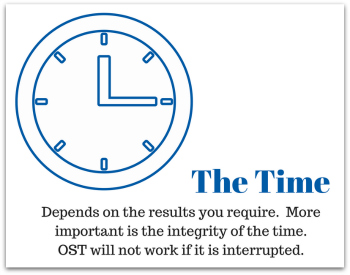
What People Say is Unique
Source: Michael Herman
- Diverse, often conflicted groups up to 1000 people, can manage hugely complex issues in minimal amounts of time, with no advance agenda preparation, and little, to no, overt facilitation.
- The conference agenda is largely unknown to participants in advance of the event, because the agenda is built in real-time, by the participants themselves, just before the conference starts.
- The entire building and delivery of the agenda typically is completed in less than 90 minutes. The result is dozens of learning sessions. A typical convened session might have 6 to 10 people participating but they can leave anytime to attend a different session. (Law of two feet)
- It is counter to the way that Western and Asian businesses have run meetings and events. The manager/leader/organizer does not decide who and what and where and when. In OST schedules, project plans, organization, staff, materials are not apparent.
- It is facilitation of group process “at scale”. As such, it is THE critical success factor in creating successful Open Space events.
Our Suggestions for Using OST
Because there is little structure in terms of what we know or are used to as structure, it can make leaders nervous. It is good to explain the benefits to them carefully, perhaps show them a video of how it works.
Ensure the following things happen:
- Every issue of concern to anybody had been laid upon the table.
- All issues were discussed to the extent that anybody cared to do that. (Law Two Feet)
- A full written record of all discussions existed and was in the hands of all participants.
- All issues were ranked in priority order.
- Critical “focal issues” had been isolated and Next Step actions identified for their resolution.
- You use all parts of the process i.e., OPENING, AGENDA SETTING, OPEN SPACE, ANNOUNCEMENTS, EVENING NEWS
Some really important things to know about the Law of two feet:
- Really make it SO clear that people can move anytime they want. Explain why it is important (see below). Demonstrate how people can do that politely and get everyone’s agreement up front that you will all use the same ritual of moving on… say to participants “ No matter what, don’t sit there feeling miserable. Unhappy people are unlikely to be productive people.
- One of the most profound impacts of the law is to make it clear who is responsible for the quality of a participant’s learning. If any situation is not learning rich, it is incumbent upon the individual participant to make it so.
- One of the more surprising gifts of the Law of Two Feet is the apparent contribution to conflict resolution. Apparently the participants do it all by themselves. Consider 100+ Zulus, Haussa, Afrikaners, and Brits struggling to gain an understanding of each other as they worked to create the New South Africa. Or how about 225 federal bureaucrats, state and local bureaucrats, and Native Americans gathered to work out approaches to building roads on tribal lands. Source: Michael Herman – see below.
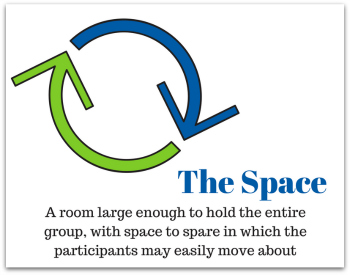
Helpful Resources


Hmmm. I hear what you are saying about the barriers to participation in OS. And personally i believe it is just fine to tinker with and adapt methods–part of the art and joy of facilitation is when one moves beyond rigid method application; personally i commonly use elements of established methods in novel ways to do my work. At the same time, i worry that the modification you are proposing would take something away from the essential spirit of OS. One beautiful thing about OS is that topics are not vetted or limited in any way, i love how anyone can post anything they have passion for, there is no consensus of any kind and autonomy and diversity are thereby increased. In my experience groups tend to “over-merge” offerings during the Marketplace stage, so when i’m leading OS i caution against that.
I’m trying to think what alternatives might address your dilemma. Regarding your reason #2, perhaps craft the invitation to clarify that no expertise is required to lead a topic, for example a topic can start with a great question and nothing more. Regarding reason #1, if people in the group don’t want to give attention to a topic, they will vote with their feet, thus there is no need for proposers to decide worthiness. Regarding reason #3, perhaps allow a few extra minutes during topic writing and tell people that if they want to partner with someone else in the room on offering something that’s ok? Those are my initial thoughts.
When participating in OS I often don’t post a topic, mostly because other topics catch my fancy more, which says alot about what I care most about. When I do post, it is something I really care about, and it’s that caring that spurs this introvert to stand up and announce my interest.
When facilitating OS, I put some effort into the pre-event invite/announcement, trying to make it clear participants will be the ones setting the agenda, in the hopes it begins the thinking process of what one may want to talk about. I also work with the client/sponsor ahead of time to shape their messaging and communications in talking-up the event, to help spread the point that participants will be creating the agenda with their interests on the theme.
In opening and inviting, I do voice a “script” for folks to use, e.g., “My name is Eric, and I am interested in talking about bike-friendly streets.” This helps downplay the need for someone to feel they should advocate for their topic, thus easing some of the public speaking anxiety. I’ve also observed at times a participant will ask their neighbor to post for them. I never asked them why, but I’m guessing they didn’t want to stand in front of everyone. Likewise, I’ve seen some younger participants ask the elder next to them if that elder would like for them to post something on their behalf.
After the first wave of postings, I do mention that folks hopefully won’t get home tonight and say “you know, they never talk about bike-friendly streets.” After the second wave of postings, I sometimes give an auctioneer’s “going once..” to let them know we’re about to move on. It’s in this final silence that we often get one more from someone who’d been sitting there sensing their passion for their topic, and jumping up to propose it.
To reduce anxiety on whether anyone else is interested, I’ll point to the principles that it’s OK if you’re the only one who shows up for your topic, and then I’ll share a story of once I had a participant propose a topic, convened it and no one else showed up, yet he cared enough to stay there and put his thoughts into the notes, which were then read by the board of the organization hosting the event, and they invited him onto the board the next month and he served the organization for years, and pointing out you never really know the extent of your influence when you stand up for what you care most about.
While I too will often tweak and morph methods to suit different situations, the OS framework has a certain simple elegance that, when properly accommodated for, has yielded some remarkable results, in my experience, and I’m reluctant to change anything. If it cannot be accommodated, due to logistics, topic, organization, or whatever, then I’ll look to another way of doing things than design a change to OS.
I can understand – and have experienced my own – hesitancy in posting a topic, but when facilitating OS I already know not everyone will be proposing topics, nor does everyone need to, because I’m confident they’ll get something from elsewhere in the process. I just try to make it as easy as possible for sparks of passion to grow into a desire to post a topic. That’s what I’ve noticed so far.
I agree with both postings above. As facilitators we can play with open space but also need to be aware we can accidentally close it. In 3s if my topic gets negative non verbal feedback etc. I can sympathize and experience the anxiety for myself and the group so I have played with multiple starting gambit but it usually outweighed by the opportunity really open space represents. I have experienced this is one value of scheduling minimum of 3 rounds so people realize more opportunities to name a topic. Also that the naming cards are always in the circle so spontaneity can lead to more topics naturally.
Hi Barbara and Tree (Tree, I have met you in Calgary during your GroupWorks presentations –
love GroupWorks!!) I have used OST quite a bit and like this idea, Barbara, and think it would
largely depend on my knowledge of the group (are they familiar with co-creating)
and what they hoped for an outcome (can it be a true collaboration, open to any result).
I recall one time when I was asked to “seed” some questions with some “experts” on the topic –
we called it a modified
Open Space. We had a true OST process followed by these seeded topics. I still regret agreeing
to this as it changed the collaborative and co-creating dynamic. Good news is that everyone felt
ownership in the results (or said they did). I also like Tree’s idea of suggesting people partner if they
wish. I have not found that people are shy to come forward with their Marketplace ideas during
agenda setting if given enough time to ponder. I also promote the idea of the Butterflies milling
around the coffee table even at this agenda stage to help with idea generating.
Overall, I also like that we can modify processes based on the group we are working with.